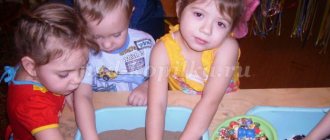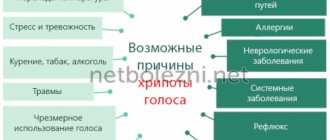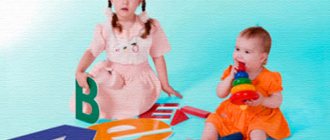Article:
When eliminating speech disorders, the leading approach is speech therapy, the main forms of which are education, training, correction, compensation, adaptation, rehabilitation. There are various classifications of teaching methods. In speech therapy work, various methods are used: practical, visual and verbal. The choice and use of one or another method is determined by the nature of the speech disorder, the content, goals and objectives of correctional speech therapy, the stage of work, the age, individual psychological characteristics of the child, etc. At each stage of speech therapy work, the effectiveness of mastering correct speech skills is ensured by the corresponding group of methods . Thus, the stage of sound production is characterized by the predominant use of practical and visual methods; during automation, especially in connected speech, conversation, retelling, story, i.e., verbal methods are widely used.
When eliminating alalia, practical and visual methods are also used to develop the sensory sphere, motor skills, and cognitive activity of the child. At the same time, when consolidating the correct skills of grammatical forms of inflection and word formation, along with visual methods, verbal ones are also used.
When eliminating stuttering in preschool age, the effectiveness of speech therapy work is achieved by practical and visual methods. Starting from school age, verbal methods combined with visual ones are predominantly used in eliminating stuttering.
Practical methods of speech therapy include game exercises and modeling.
Exercise is the child’s repeated repetition of practical and mental actions. In speech therapy work, they are effective in eliminating articulatory and voice disorders, since children develop practical speech skills or the prerequisites for their development, and master various methods of practical and mental activity. As a result of systematically performing articulatory exercises, the prerequisites are created for sound production and for its correct pronunciation. At the stage of sound production, the skill of its isolated pronunciation is formed, and at the automation stage, the correct pronunciation of sound in words, phrases, sentences, and coherent speech is achieved.
Mastering correct language skills is a long-term process that requires a variety of systematically used activities.
Exercises are divided into imitative-performing, constructive and creative.
Imitative-performing tasks are performed by children in accordance with the model. In speech therapy work, a large place is occupied by practical exercises (breathing, vocal, articulatory, developing general, manual motor skills). At the initial stages of assimilation, demonstration of actions is used, and during repetitions, as the method of action is mastered, the visual demonstration is increasingly “collapsed” and replaced by verbal designation. Thus, the implementation of articulatory exercises is initially carried out according to a visual demonstration, based on the visual perception of the tasks performed by the speech therapist; in the future they are only called.
In speech therapy work, various types of construction are used. For example, when eliminating optical dysgraphia, children are taught to construct letters from elements, from one letter to another.
Speech exercises are also used in speech therapy work. An example of this is the repetition of words with assigned sounds when correcting problems with sound pronunciation.
The use of play exercises (for example, imitation of actions: cutting wood, trees swaying in the wind, imitation of the gait of a bear, fox) causes an emotionally positive mood in children and relieves their stress.
Performing any exercises contributes to the formation of practical skills only if the following conditions are met:
the child's awareness of the goal. This depends on the clarity of the task, the use of the correct demonstration of methods of execution, the disaggregation of the demonstration of complex exercises, taking into account the age and mental characteristics of the child; systematicity, which is realized in repeated repetition (in speech therapy classes, outside of them, in class, during extracurricular time using a variety of speech and didactic material and various situations of speech communication); gradual complication of conditions, taking into account the stage of correction of the age and individual psychological characteristics of the child; conscious implementation of practical and verbal actions; independent performance at the final stage of correction (although at the initial stages of correction, exercises can be performed with the help of a speech therapist, with mechanical assistance, etc.); differentiated analysis and assessment of implementation.
Various games are used with preschool children: singing, didactic, active, creative, dramatization. Their use is determined by the tasks and stages of correctional speech therapy work, the nature and structure of the defect, the age and individual mental characteristics of children.
Modeling is the process of creating models and using them to form ideas about the structure of objects, the relationships and connections between the elements of these objects.
The effectiveness of their use depends on the following conditions:
the model must reflect the basic properties of the object and be similar in structure to it;
be accessible to a child of a given age;
should facilitate the process of mastering skills, abilities and knowledge.
Sign-symbolic modeling has become widely used. For example, when forming sound analysis and synthesis, graphic diagrams of the structure of a sentence, the syllabic and sound composition of a word are used.
The use of a model presupposes a certain level of formation of mental operations (analysis, synthesis, comparison, abstraction, generalization).
Visual methods are those forms of assimilation of knowledge, skills and abilities that are significantly dependent on the visual aids and technical teaching aids used in teaching.
The use of manuals facilitates the assimilation of materials and contributes to the formation of sensory prerequisites for the development of speech skills. Reliance on sensory images makes the acquisition of speech skills more specific, accessible, and conscious, and increases the effectiveness of speech therapy work.
Visual methods include observations, looking at drawings, paintings, models, watching filmstrips, films, listening to records, tape recordings, as well as showing a sample task, a method of action, which in some cases act as independent methods.
Observation involves the use of paintings, drawings, articulation profiles, models, as well as showing sound articulation and exercises.
The use of these benefits helps to clarify and expand children's ideas, develop cognitive activity, and creates a favorable emotional background for speech therapy work.
Visual aids should:
be clearly visible to everyone; selected taking into account the age and individual psychological characteristics of the child; meet the objectives of speech therapy work at this stage of correction; be accompanied by precise and specific speech; a verbal description of an object should contribute to the development of analytical-synthetic activity, observation, and speech development.
The use of manuals can pursue various goals: correction of sensory disturbances (ideas about color, shape, size, etc.), development of phonemic perception (in a picture, find objects whose names contain the sound being practiced), development of sound analysis and synthesis (find objects in a story picture, the name of which has 5 sounds), consolidation of the correct pronunciation of sounds, development of vocabulary, grammatical structure, coherent speech (composing a story based on a story picture, a series of story pictures).
Computer technologies and films are used to automate speech sounds during a conversation when retelling content, to develop the skills of fluent speech when eliminating stuttering, and to develop coherent speech.
Features of the use of verbal methods in speech therapy work are determined by the age characteristics of the children, the structure and nature of the speech defect, goals, objectives, and the stage of correctional intervention.
When working with preschool children, verbal methods are combined with practical visual ones. When eliminating dyslalia, stuttering and other speech disorders in preschool age, the speech therapist relies on the use of playful and visual methods with the inclusion of verbal ones.
At school age, it is possible to use only verbal methods without supporting them with visual and practical ones. For example, when eliminating stuttering in children of senior school age, conversations about books read, memorization of poems, retelling of what they read, stories from personal experience, and discussions are used.
The main verbal methods are story, conversation, reading.
A story is a form of teaching in which the presentation is descriptive. It is used to create in children an idea of a particular phenomenon, to evoke positive emotions, to create a model of correct expressive speech, to prepare children for subsequent independent work, to enrich their vocabulary, and to consolidate grammatical forms of speech.
In addition to the story, retelling of fairy tales and literary works is used (short, selective, extended, etc.).
Depending on the didactic tasks, preliminary, final, generalizing conversations are organized. During the preliminary conversation, the speech therapist identifies the children’s knowledge and creates a mindset for mastering a new topic. For example, when differentiating the sounds ts - ev in a preliminary conversation, the sound s is highlighted, then ts, their articulation is clarified based on the children’s experience. Then the sounds are compared and the existing knowledge is generalized. The final conversation is conducted to consolidate and differentiate speech skills.
Based on analysis, synthesis, comparison, generalization, the essential properties of speech and its elements are isolated.
In the inductive form of conversation, facts are first reproduced, analyzed, compared, and then generalized (from particular to general). In the deductive form, a generalization is first given, and then specific facts are found to confirm it.
The use of conversation in speech therapy work must meet the following conditions:
rely on a sufficient amount of ideas, the level of speech skills, and be in the child’s zone of proximal development;
correspond to the logic of the child’s mental activity, take into account the peculiarities of his thinking;
activate children’s mental activity using a variety of techniques, including leading questions;
questions should be clear, precise, requiring an unambiguous answer;
the nature of the conversation must correspond to the goals and objectives of correctional work.
When conducting a conversation, various tasks are set: developing cognitive activity, consolidating correct pronunciation, clarifying the grammatical structure of sentences, consolidating the skills of smooth continuous speech, etc.
In the process of speech therapy, a variety of verbal techniques are also used: showing a sample, explaining, explaining, pedagogical assessment.
Explanation and explanation are included through visual and practical methods. For example, when producing sound, along with the demonstration, the speech therapist uses an explanation of its correct articulation, pays attention to the position of the tongue and lips, and accompanies the demonstration with explanations.
Of great importance in speech therapy work is the pedagogical assessment of the result of completing a task, the method and progress of its implementation. It helps improve the quality of the correction process, stimulates and activates the child’s activity, and helps the formation of self-control and self-esteem.
When assessing a child’s activity, it is necessary to take into account his age and individual psychological characteristics. Unconfident, shy, and acutely aware of their defects should be more often encouraged to show pedagogical tact when assessing their work.
Speech therapy intervention is carried out in the following forms of training: frontal, subgroup, individual lesson, lesson.
According to the nature of their focus, methods of speech therapy work are divided into methods of “direct influence” (for example, influencing articulatory motor skills when eliminating dyslalia) and methods of “bypass paths” (for example, creating new functional connections bypassing the damaged parts of the speech functional system in aphasia).
Criteria for speech development of a preschooler
The examination is carried out to identify the following features of the preschooler’s speech:
- the volume of available speech skills, to what extent it meets the standards;
- to what extent speech skills correspond to the child’s psychological level; how developed are speech defects; how does the compensatory background manifest itself? how active the child is in speech and cognitive activity;
- how well the sound component of speech has been mastered;
- how complete is the vocabulary;
- How developed is the grammatical language system?
It also studies how well the child understands other people’s speech and how actively he uses his own.
Corrective work with preschoolers suffering from ODD is carried out in groups specially designed for such children.
Literacy development
Forming sound pronunciation also involves teaching children the basics of literacy. This work is relevant for children 5-6 years old.
Corrective work is carried out with the following goals:
- prepare preschoolers for full literacy training;
- develop in preschoolers the basic skills necessary to master reading and writing.
For teaching literacy, material is selected based on sounds already practiced in pronunciation. The set of activities implies a correspondence between the acquired sounds and the forms of sound analysis that are used during reading or writing.
To develop the ability to analyze sounds, special classes are held that allow you to isolate all the sounds in any word. For example, children pronounce vowels or other types of sounds for a long time, loudly pronounce labial sounds, and highlight explosive sounds using volume. This approach to exercises allows the preschooler to explore the sound composition of words while pronouncing them. Special visual diagrams are drawn up, where the role of sounds is played by chips.
This work allows children to learn what concepts such as “sounds”, “words”, “syllables”, “sentences” mean. Preschoolers also learn to distinguish between hard and soft sounds, dull and voiced.
With a skillful approach, preschoolers can also learn to put together short syllables and three-letter words from different sounds.
Every day, the teacher should devote a little time in the evening to consolidate the skill of adding syllables and words.
Letters are studied in a sequence that depends on the difficulty of articulating sounds. This approach is being introduced in general classes. Any exercise must contain game elements. It is also useful to use elements of competition.
Preschoolers practice selecting words whose number of syllables matches the number of claps. They are also given syllables from which they need to come up with whole words. Another interesting task: add a missing syllable in a word. Children also enjoy selecting images whose names consist of a given number of syllables.
As preschoolers learn letters, they are even able to write those syllables into word charts.
Such exercises are first introduced into classes as fragments. Gradually they take on the role of leading exercises, which form the main part of the individual work of students. Preschoolers begin to realize that every syllable has a vowel sound. And the number of vowel sounds determines the number of syllables within a word.
The next step is teaching preschoolers to divide a sentence into separate words. This is how children learn to determine how many words are in a sentence and in what order they are located. Sentences must be selected so that their content is familiar to children.
Formation of auditory perception
The first stage includes tasks that help preschoolers develop understanding of speech:
- preschoolers learn to distinguish an object and its constituent elements, as well as their signs and functions (“bring me a stool, please. Show me where its legs are and where the seat is”);
- preschoolers learn to determine the direction of actions and where objects are (“put your pen on the table and your notebook in the drawer”);
- preschoolers learn to understand the transition of actions and point out their signs (“bring all the red pens, take away all the blue ones”);
- children learn to determine the direction of actions and their functions.
The next stage involves the use of tasks like: “bring the bear, dress it, put it in the crib, cover it with a blanket.” Children follow these instructions and pronounce each of their actions.
By completing all these tasks, the child practices basic speech forms. He practices answering questions. At first these answers are very short, then longer. Gradually, this allows the preschooler to learn to take an active part in the dialogue.
Speech therapy classes provide an opportunity for preschoolers not only to answer questions asked, but also to correctly formulate questions themselves.
Play activities should be used to encourage children to ask each other questions. The result should depend on this skill.
Training tasks for speech correction
The main learning objectives in these groups are:
- mastery of lexical and grammatical language means;
- formation of coherent speech;
- development of the phonetic aspect of speech: articulation, hearing, sound pronunciation, etc.;
- formation of basic skills in sound synthesis and analysis;
- mastering the elements of literacy.
How effectively the work is organized will depend on the organization of the learning process, on the competent distribution of the teaching load, on compliance with the principle of continuity between the activities of the educator and the teacher, who should strive to implement common educational objectives.





